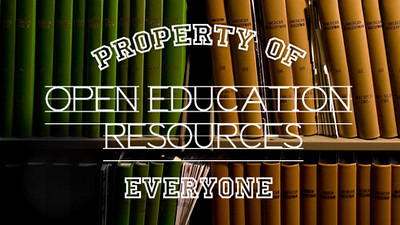Open Educational Resources
Open Educational Resources (OERs) can be defined as "teaching, learning and research materials in any medium – digital or otherwise – that reside in the public domain or have been released under an open license that permits no-cost access, use, adaptation and redistribution by others with no or limited restrictions." (United Nations Educational, Scientific and Cultural Organization (UNESCO). OER can be: Open textbooks, videos, images, lesson plans, modules, course materials, games and software.

Image by OpenSource.com on Flick
Open Educational Resources are different from Open Access journals in that the latter involves removing barriers such as price and permissions from the consumer, with ownership and copyright restrictions still in place; whereas the former typically allows for use, adaptation, and redistribution with minimal restrictions. It should be noted that both OERs and Open Access material are different from what we'll call "institutionally licensed" material, which includes access to materials only available through St. Clair College credentials (e.g., materials accessed from the library that require institutional log-in). These types of material are licensed/copyrighted works that the College has paid a subscription to access, and are not considered to be in the public domain. Introduction to OER Video[footnote]“Introduction to Open Educational Resources” by Abbey Elder and adapted by Josie Gray is under a CC BY 4.0 Licence. In this adapted version, two slides were replaced with Canadian-specific content and sections were removed. The conversation around OERs is not new, and the concept of what makes a resource "open" has been previously discussed by David Wiley in his 5R framework:
- Retain: the right to make, own, and control copies of the content
- Reuse: the right to use the content in a wide range of ways (e.g., in a class, in a study group, on a website, in a video)
- Revise: the right to adapt, adjust, modify, or alter the content itself (e.g., translate the content into another language)
- Remix: the right to combine the original or revised content with other open content to create something new (e.g., incorporate the content into a mashup)
- Redistribute: the right to share copies of the original content, your revisions, or your remixes with others (e.g., give a copy of the content to a friend)
Learn more about Open Education with David Wiley in this TEDtalk.
Learn more about Open Education Resources with The Learning Portal's OER Tool Kit.
Open Educational Practices
Open Educational Practices (OEP), also called "Open Pedagogy", captures pedagogical activities and approaches that foster a shared, collaborative approach to teaching and learning that is informed by the same spirit as found in OER (Skidmore & Provida, 2019)[footnote]Skidmore & Provida, 2019 - Full reference here[/footnote]. In other words, OEP is the use of OER to support learning, or the open sharing of teaching practices with a goal of improving education and training at the institutional, professional, and individual level. By using open pedagogy in your classroom, you are inviting your students to be part of the teaching process, participating in the co-creation of knowledge (BC Campus).
Open pedagogy in the classroom
There are many ways of building open pedagogy into your learning environment. You can engage your students to create a set of exercises for a specific chapter in an open textbook, or incorporate student assignments into a collection of OER which could be submitted as part of a future open textbook or used in conjunction with an existing resource. Instead of using disposable assignments that offer no value to the student or the instructors, your students, under your direction and supervision, can build a resource designed to improve the learning space for future students (BC Campus). A portion of the section on OEP is attributed to BC Campus OpenEd Resources and is licensed under a Creative Commons Attribution 4.0 International License (CC-BY 4.0).
Top 10 myths about open educational resources (OER)
Acknowledgment
This module wasmade possible with funding by the Government of Ontario and through eCampusOntario’s support of the Virtual Learning Strategy. To learn more about the Virtual Learning Strategy visit: https://vls.ecampusontario.ca.
Contributor:
- Irene Stewart, Retention Coordinator

This work is licensed Creative Commons Attribution Non-Commercial ShareAlike by St. Clair College, Centre for Academic Excellence and Quality Assurance unless otherwise noted.